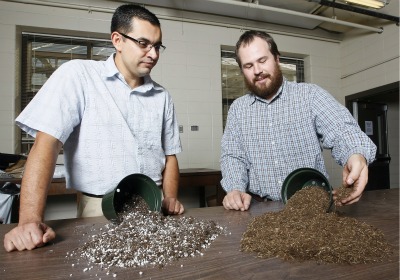
Nov. 8, 2010, West Lafayette, IN – Greenhouse plant growers can
substitute rice hulls for perlite in their media without the need for an
increase in growth regulators, according to a Purdue University study.
Nov. 8, 2010, West Lafayette, IN – Greenhouse plant growers can substitute rice hulls for perlite in their media without the need for an increase in growth regulators, according to a Purdue University study.
Growing media for ornamental plants often consists of a soilless mix of peat and perlite, a processed mineral used to increase drainage. Growers also regularly use plant-growth regulators to ensure consistent and desired plant characteristics such as height to meet market demands. Organic substitutes for perlite like tree bark have proven difficult because they absorb the plant-growth regulators and keep them from getting to the plants. Using bark requires a 25 per cent increase in the volume of growth regulators applied.

|
| Roberto Lopez, from left, and Chris Currey have shown that rice hulls (at right) can be used as a substitute for perlite in growing media without affecting plant growth regulators. (Purdue Agricultural Communication photo/Tom Campbell) |
“We were not sure whether rice hulls, as an organic component, would hold up the growth regulator,” said Roberto Lopez, a Purdue assistant professor of horticulture and co-author of a HortTechnology paper that outlined the findings. "Testing showed that there were no differences in plants grown with rice hulls or perlite."
Pansies and calibrachoa were planted in an 80/20 mix of both peat and perlite and peat and rice hulls and then treated with several different growth regulators. The plants treated with and without growth regulators and grown in peat and perlite and peat and rice hulls had similar heights and stem lengths.
Finding a waste product to replace perlite could reduce the price of growing media since perlite must be mined and heat processed.
“It's a really energy-intensive process and, because it's a mineral, it's non-renewable,” said Chris Currey, a horticulture graduate student and co-author of the HortTechnology paper.
Rice hulls are an attractive option, Lopez said, because they can be easily transported on barges and rice growers in the South could increase profits by selling a traditional waste product.
“Often these rice hulls were being burnt because there's not a lot of other use for them,” Lopez said.
Syngenta and Fine Americas funded the research. Lopez and Currey collaborated with Purdue research technician Diane Camberato and graduate student Ariana Torres.
Brian Wallheimer is a communications specialist with Purdue University.
Print this page